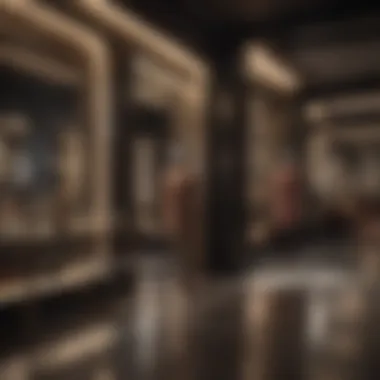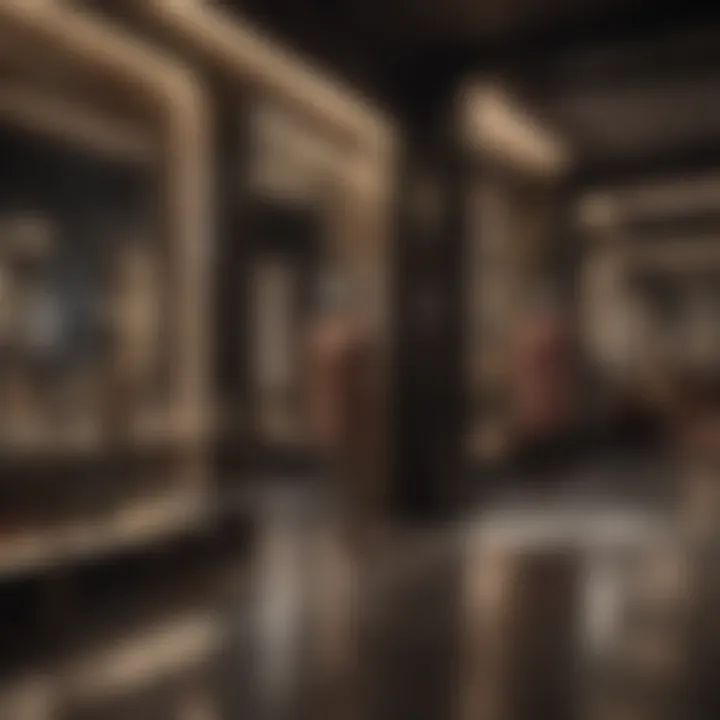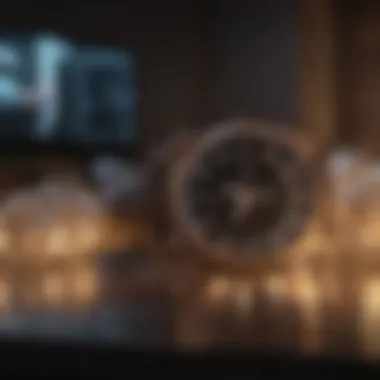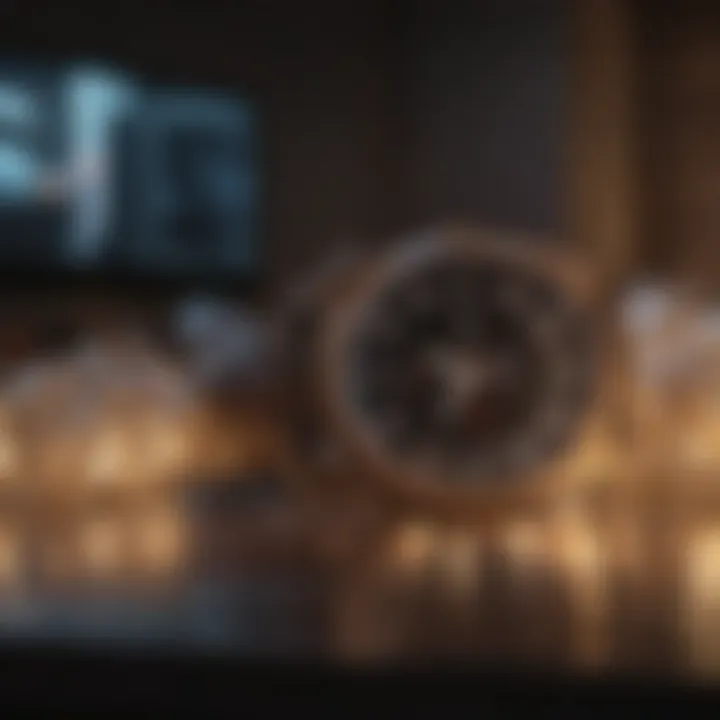Discover the Finest Online Luxury Boutiques


Intro
The world of luxury shopping online has blossomed into a sophisticated arena, where opulence and convenience coalesce. As the digital landscape shifts, online luxury boutiques take center stage, reshaping how shoppers engage with high-end fashion. In this guide, we’ll dive deep into what makes these boutiques unique, examine their impact on consumer behavior, and highlight the top platforms that have become go-tos for luxury aficionados. Understanding these elements is vital for discerning shoppers who navigate this intricate world, allowing them to make informed choices.
Fashion Trends
Runway Highlights
Luxury fashion houses are known for showcasing exquisite pieces on the runway, but today, the influence of these collections has seeped into online boutiques. Many platforms curate selections inspired directly by runway trends, bringing high-fashion looks to our fingertips. For instance, when Chloé presents bold prints or intricate details, you can expect similar items popping up on sites like Farfetch or Net-a-Porter shortly after. This immediacy allows savvy consumers to stay in vogue without stepping foot outside.
Seasonal Must-Haves
Each season brings its own set of must-have pieces, and with e-commerce flourishing, these items are easier to snag than ever. Think statement jackets in the fall or airy dresses in summer. Seasonal collections from brands like Gucci or Balenciaga appear in online boutiques days after the latest fashion weeks, making it simpler for fashion enthusiasts to refresh their wardrobes.
Celebrity-inspired Looks
Celebrity influence in fashion can't be overstated. Online luxury boutiques often capitalize on this by featuring sections dedicated to celebrity-inspired looks. Whether it's a designer bag spotted on Blake Lively or a stunning dress worn by Zendaya, boutiques like Moda Operandi mimic these styles, making it easy for shoppers to recreate red carpet elegance in their daily lives.
Consumer Behavior
As the paradigm of luxury shopping evolves, and digital platforms mature, it's fascinating to observe how consumer behavior adapts. The trend points towards a desire for authenticity and direct interaction with brands. Customers now scrutinize the story behind each piece. Therefore, transparency in luxury boutiques becomes key; knowing where pieces come from can not only influence buying choices but also build trust.
"Today's luxury consumers are more informed and demand genuine experiences. They want to wear a story, not just a brand."
Many consumers, especially millennials and Gen Z, prioritize sustainability and ethical production. They delve into the values of the brands they support, thus shaping their purchasing choices, which online luxury boutiques such as Reformation and Stella McCartney have expertly embraced.
Key Online Luxury Platforms
Identifying the best platforms is essential for anyone looking to upscale their fashion game. Some notable names include:
- MatchesFashion: Known for its curated selection, it presents an elegant blend of contemporary brands and timeless luxury labels.
- SSENSE: This site is a treasure trove for streetwear and high-fashion blends, catering to a younger crowd.
- Farfetch: Acts like a global marketplace, bringing unique boutique selections from around the world to a single screen.
Each of these platforms provides a distinct shopping experience, appealing to different taste and lifestyles. Notably, they often feature exclusive collections and limited-edition items, which can turn heads and spark conversation.
The Future of Luxury eCommerce
As technology grows, so too does the potential for an enhanced online shopping experience. Virtual reality and augmented reality options are on the horizon, allowing consumers to 'try before they buy' in innovative ways. Furthermore, as luxury boutiques continue to embrace e-commerce, the future looks bright with possibilities for personalization and curated experiences designed around individual preferences.
Understanding Online Luxury Boutiques
In the fast-paced realm of fashion, the concept of luxury has taken on a new meaning. The emergence of online luxury boutiques has transformed how consumers engage with high-end brands, breaking boundaries and reshaping traditional retail experiences. To grasp the significance of this evolving landscape, it's essential to dissect the characteristics of online luxury boutiques and explore what they offer to discerning shoppers.
Defining Luxury in the Digital Age
Luxury fashion, in simple terms, refers to products that symbolize prestige, elegance, and exclusivity. However, in today's digital age, luxury is often more than just a hefty price tag or a renowned designer label. It's an experience that includes convenience, accessibility, and personalization—all of which online boutiques successfully deliver. With fashion no longer limited to physical stores in high-end districts, luxurious shopping now fits right in the palms of consumers’ hands.
Brands like Gucci, Balenciaga, and Prada are leveraging e-commerce platforms to reach a broader audience while maintaining the allure of exclusivity. In turn, discerning shoppers expect not just top-notch products but also engaging experiences that resonate with their senses.
It's vital to consider how the digitization of luxury poses questions about authenticity and sustainability. As online boutiques flourish, the line between genuine luxury and mass-produced components can sometimes blur. Consumers find themselves in a complex maze, balancing their desires for high quality with a deeper awareness of production practices.
The Rise of E-Commerce in Luxury Fashion
The shift toward e-commerce has been nothing short of remarkable, especially in the context of luxury fashion. Statistics reveal that online luxury sales have been growing at an impressive rate, with some estimates indicating a growth trajectory of around 25% year over year. Shoppers now enjoy the advantage of browsing through an extensive array of exquisite products from the comfort of their homes.
- Global Reach: E-commerce erases geographical constraints. Whether a shopper resides in New York or a quaint town in Italy, high-end products are accessible at their fingertips.
- 24/7 Availability: Unlike physical boutiques constrained by opening hours, online platforms operate around the clock. This flexibility appeals to busy individuals who want to shop at their leisure.
- Rich Content: Many luxury e-commerce sites also offer rich product details, including high-resolution images, 360-degree views, and comprehensive descriptions. This level of information aids consumers in making informed decisions.


"The true luxury of shopping online isn’t just in the items themselves but in the story they tell and the experience they foster."
Despite these benefits, it's essential to acknowledge the challenges encountered by these online luxury boutiques. Authenticity and the threat of counterfeiting loom large, making trust essential in this digital marketplace. Brands now invest heavily in ensuring that their online presence reflects luxury in every aspect—from impeccable customer service to elegantly designed interfaces.
In summary, understanding the nuances of online luxury boutiques demands an appreciation for the shifting definitions of luxury, and the pivotal role e-commerce plays in modern shopping habits. As we weave through the following sections, the exploration will unfold, highlighting key characteristics and prominent platforms that shape this dynamic market.
Key Characteristics of Luxury Boutiques
Online luxury boutiques operate in a realm distinctly different from mass-market retail platforms. Understanding the unique traits that define these boutiques offers valuable insight for anyone looking to navigate the world of luxury shopping. Key characteristics encompass exclusivity, personalized experiences, and carefully curated selections, all of which significantly influence consumer behavior and set these platforms apart from traditional retail.
Exclusivity and Limited Availability
When it comes to luxury shopping, the allure of exclusivity cannot be overstated. Shoppers are not just purchasing a product; they often seek a sense of belonging to an elite circle. This exclusivity is cultivated through limited availability. Many luxury boutiques offer collections in small quantities or one-of-a-kind items, fostering a sense of urgency and desirability.
The psychological aspect of exclusivity plays a crucial role here. Limited releases make a customer feel special, as if they are partaking in something others cannot easily access. For instance, brands like Balenciaga or Maison Margiela often drop a capsule collection online, and if you blink, you might miss it. This scarcity not only enhances the perceived value of the items but also cultivates a unique shopping experience – one that makes consumers feel they own something remarkable, not just another piece of clothing.
Personalized Shopping Experiences
In the world of luxury online shopping, personalization is key. Customers expect tailored recommendations, customized interactions, and attentive customer service that goes above and beyond the norm. This can include everything from curated lists based on past purchases to personalized styling assistance.
Imagine logging onto a platform like Net-a-Porter, where based on your browsing history, the website suggests elegant outfits for an upcoming gala. The boutique's ability to use algorithms and historical data enhances your shopping experience, making each visit feel especially catered to you. The warmth of a personal touch in the digital marketplace fosters loyalty, as clients feel recognized and valued—not just a faceless buyer among thousands.
Curated Selections and Brand Partnerships
Beyond just selling products, luxury boutiques excel at curating selections that resonate with brand aesthetics and the targeted consumer demographic. This means having an eye for quality and a knack for picking pieces that align with current trends without losing the essence of timeless elegance.
Boutiques like Farfetch collaborate with hundreds of designers and brands, allowing them to showcase unique items that might not be found in every department store. This ensures that shoppers are not just getting what everyone else has—they are offered something distinct, creating a luxurious feel. The partnerships often extend to exclusive items or limited-edition releases, turning shopping into an experience of discovery and innovation.
In summary, the key characteristics of luxury boutiques are essential to comprehending how they carve a niche in the expansive online fashion landscape. By emphasizing exclusivity, tailoring personalized experiences, and offering curated selections, these platforms entice a discerning audience seeking more than mere products—they are in search of an identity, an experience, and an understanding of luxury in a digital age.
Prominent Online Luxury Boutiques
The rise of digital commerce has transformed the landscape of luxury shopping. With the click of a button, shoppers can access a world of exquisite fashion, curated pieces, and exclusive brands. Prominent online luxury boutiques play a vital role in this new era. They offer not just products but also a tailored experience that aligns with the sophisticated tastes of modern consumers.
These platforms allow shoppers to explore high-end items that reflect their personal style, often punctuated by unique offerings and limited editions. The following sections will delve into four key online luxury boutiques, each standing out in its own unique niche, providing insights into their specific elements, benefits, and what sets them apart in the crowded online marketplace.
Discovering Net-a-Porter
Net-a-Porter has carved a niche for itself in the online luxury domain, often recognized as a pioneer in the sector since its inception in 2000. Upon entering the site, users are greeted with a sleek design that feels both modern and luxurious. This boutique is renowned for its curated selection of designer clothing, accessories, and beauty products. Why is this important?
- Prestigious Brands: Net-a-Porter presents a wide array of prestigious brands, like Balenciaga and Gucci, catering to fashion enthusiasts craving items from top-tier houses.
- Editorial Content: The platform doesn’t just sell products; it offers equally compelling storytelling through its editorial content. The magazine-style layout combines fashion advice with in-depth articles, helping customers make informed decisions.
- Personalized Services: They also provide tailored recommendations based on shoppers’ preferences, enhancing the buying experience.
This amalgamation of offerings creates a personalized shopping journey that’s hard to match in the online world.
Examining Farfetch's Global Reach
Farfetch stands as a testament to the global nature of luxury retail. With its unique business model, it connects buyers to boutiques and brands worldwide. But what makes Farfetch particularly interesting?
- International Marketplace: The platform hosts an array of independent boutiques from diverse locations. This ensures that shoppers encounter an eclectic selection of styles from around the globe, not just the mainstream.
- Transcending Borders: Farfetch’s logistics allow for seamless shopping across markets. Orders from distant locales can arrive at your doorstep, giving you access to styles you might not find locally.
- Sustainability Efforts: Increasingly, they focus on sustainability, providing options for pre-owned luxury items and collaborating with brands that emphasize ethical production practices.
With such diverse offerings and an eye toward sustainability, Farfetch represents a compelling choice for those looking to shop beyond the horizon.
Exploring MatchesFashion's Unique Offerings
MatchesFashion captures the essence of elegance with a distinctly curated approach. It carefully selects designers while also ensuring a comprehensive shopping experience. Here’s what sets it apart:
- Rich Editorial Influence: The site is filled with unique editorial content that encompasses current fashion trends and style guides. This content creates a rich ecosystem where style meets commerce.
- Trendy Collaborations: MatchesFashion goes further by including rising designers alongside well-known brands, which captures the spirit of discovery.
- Bespoke Shopping Services: Customers can access personal shopping consultations, granting insights tailored to their preferences and helping them navigate their luxury journey with ease.


This combination enlivens the shopping experience while also spotlighting unique finds.
Understanding SSENSE's Contemporary Appeal
SSENSE emerges as a favorite among younger luxury consumers, blending high fashion with streetwear elements. Its unique angle provides an arresting shopping experience.
- Edgy Aesthetic: The site's design and product offerings reflect an edgy, contemporary aesthetic. It features an assortment of avant-garde and high-fashion brands like Rick Owens and Off-White.
- Content and Culture: Aside from shopping, SSENSE invests in cultural content that speaks to a more youthful demographic, incorporating articles, interviews, and videos that explore fashion, art, and culture.
- Exclusive Drops: They often host exclusive product drops not found on other platforms, attracting shoppers eager to get their hands on the latest trends before they sell out.
This blend of contemporary culture and luxury creates a captivating experience that resonates with a younger audience seeking more than just a shopping trip.
Consumer Behavior in Luxury Shopping
Understanding how consumers interact with luxury boutiques online is essential to grasping the broader trends of modern retail. The way people shop, especially for high-end products, has evolved dramatically, influenced by changing lifestyles, technology, and economic factors. This section will explore the nuances behind consumer preferences and how they navigate their online luxury shopping experience.
Shift Towards Online Purchases
In recent years, the pivot towards online shopping has been nothing short of a revolution. This shift isn't merely a response to convenience; it's a fundamental change in how consumers engage with luxury brands.
- Accessibility: Online platforms break down geographical barriers, offering shoppers access to boutiques that were once limited to certain locales. A fashion enthusiast in Tokyo can now browse exclusive collections from Paris, all from the comfort of their home.
- Instant Gratification: With the rise of fast shipping options and seamless mobile apps, luxury shoppers are now accustomed to having what they want at their fingertips. This has created a new standard for speed and efficiency in luxury retail.
- Diverse Choices: The range of products available online vastly exceeds what any physical store could offer. Shoppers can compare styles, prices, and availability across multiple boutiques in a matter of clicks.
Understanding this shift is crucial for both consumers and brands. Those shopping for luxury goods now value their time and expect a shopping experience that meets their elevated standards. As a result, luxury boutiques must adapt their online presence to cater to these discerning customers who prioritize both luxury and convenience.
"In the realm of luxury shopping, every click brings you one step closer to timeless elegance, but it’s the ease of access that truly alters the landscape."
Understanding Value Perception
Value perception in luxury shopping is intricate and multifaceted. It's not just about the price tag. For many consumers, the allure of luxury is tied to emotional and psychological factors.
- Brand Narrative: Consumers are drawn to the stories behind brands — their heritage, craftsmanship, and exclusivity. A handbag is not just a handbag; it's an emblem of status and a symbol of artistry.
- Quality Assurance: Shoppers often believe that higher prices correlate with superior quality. This trust influences their purchasing decisions, leading them to gravitate towards brands that reinforce their expectations of luxury.
- Social Influence: The social circles a consumer occupies can impact their perception of value, such that owning a specific item becomes intertwined with their identity and aspirations. This social validation is often seen in platforms like Instagram, where luxury becomes a part of lifestyle branding.
Understanding these elements allows luxury brands to create deeper connections with their customers. By focusing on the perceived value, online boutiques can innovate in their storytelling and marketing strategies to resonate with their audience on a personal level.
The Role of Technology in Luxury Shopping
In today's whirlwind of digital advancements, the intersection between luxury and technology has emerged as a significant theme in the fashion world. Online luxury boutiques are not just adapting to technological innovations; they are thriving because of them. The importance of technology in luxury shopping cannot be overstated—it shapes the customer experience, enhances accessibility, and redefines how brands engage with their clientele. Here, we delve into two key facets of this technological revolution: augmented reality and AI-driven recommendations.
Augmented Reality and Virtual Fitting
Augmented reality (AR) has sparked a transformation in how shoppers interact with products before making a purchase. Particularly in fashion, the ability to visualize an item in real-time and in one’s personal space can bridge the gap between online and in-store experiences. For instance, brands like Gucci and ASOS have utilized AR to create features that allow customers to try on clothes virtually. By simply pointing their smartphones at themselves, shoppers can see how a particular dress or pair of shoes might look, without the hassle of returning unworn items.
This trend is particularly relevant when considering the common concerns about fit and style during online purchases. Shoppers often hesitate, fearing that the item won't match their expectations. AR helps eliminate those qualms.
Some notable benefits of augmented reality include:
- Enhanced Visualization: Shoppers can see how clothes will fit and move with their bodies, making the shopping experience more engaging.
- Reduction in Returns: By allowing consumers to try before they buy, AR can significantly lower return rates—a win-win for both customers and retailers.
- Interactive Marketing: Engaging customers this way makes shopping more fun and personalized, fostering brand loyalty.
"Augmented Reality allows luxury brands to bring the fitting room experience directly to the customer’s living room."
AI-Driven Recommendations
As the digital landscape continues to evolve, artificial intelligence (AI) emerges as a game changer in tailored shopping experiences. Luxury boutiques are leveraging AI to analyze customer behavior, preferences, and past purchases, creating a personalized shopping experience that feels bespoke and curated.
For instance, platforms like Net-a-Porter utilize AI to recommend items to users based on their browsing history and preferences. This intelligent system analyzes vast data sets to suggest complementary items that a shopper might not have considered but could potentially love.
The advantages of AI-driven recommendations in luxury shopping are numerous:
- Personalization: Every customer enjoys a unique shopping journey, tailored to their taste and style. This connection fosters an emotional bond between the consumer and the brand.
- Time Efficiency: With tailored suggestions at their fingertips, customers spend less time scrolling through endless options, making the shopping process more efficient.
- Increased Sales Potential: Personalization boosts conversion rates because customers are more likely to buy products they feel are recommended just for them.


Challenges Faced by Online Luxury Boutiques
Online luxury boutiques operate in a landscape that's as glamorous as it is complex. Navigating through these challenges is crucial for both the businesses themselves and the discerning shoppers they serve. Without a clear understanding of these hurdles, the allure of online luxury shopping might dim, impacting both sales and brand reputation.
Authenticity and Counterfeit Products
The threat of counterfeit goods looms large in the world of luxury fashion. As online shopping continues to boom, so does the market for imitation products that deceive unsuspecting buyers. Consumers looking to buy high-end items need assurance that what they’re purchasing is legitimate. One seemingly little misstep can transform the joy of shopping into regret.
The industry has seen a marked rise in counterfeit products, especially from platforms that don’t prioritize provenance. Authenticity checks are paramount. Trustworthy boutiques often offer thorough information about their products' origin and provide certificates of authenticity.
Moreover, brands are employing innovative technologies like blockchain to track the authenticity of luxury goods, prompting retailers to establish robust measures to combat counterfeiting. Without these measures, the reputation of even the most exclusive brands is at stake. Not only does this affect sales, but it can also harm consumer trust—once lost, it’s hard to regain.
"In today’s digital era, the notion of luxury infused with authenticity isn’t just an advantage; it’s a necessity."
Logistical Hurdles
Shipments and deliveries in luxury retail are not a walk in the park. Many factors can throw a wrench into the smooth execution of online transactions, starting with the distance between manufacturers and end-users. Luxury items often require specialized handling and packaging. Shippers must ensure that products arrive without a scratch, adding complications to logistics operations.
Besides, international shipping can become a tangled web, considering customs regulations, taxes, and tariffs. This can lead to unexpected delays and increased costs, which are less than desirable for consumers who expect swift delivery coupled with their luxury experience.
Furthermore, returns and exchanges in this segment create an additional logistical puzzle. High-end items often come with stricter return policies and expectations. Handling returns smoothly and efficiently can significantly influence customer satisfaction and retention.
- Planning for seasonal spikes in demand,
- Ensuring supply chain transparency,
- Adjusting to evolving shipping technologies.
Each of these elements demands meticulous attention to detail. If luxury boutiques fail to streamline their logistics, they might find themselves unseated by competitors who provide a more seamless shopping experience.
The Future of Boutique Shopping
As we look towards the horizon of online luxury shopping, several key trends promise to reshape the landscape. The future of boutique shopping holds considerable importance, especially in the wake of evolving consumer expectations and societal shifts. Theres a palpable shift towards sustainability, coupled with the undeniable influence of digital communication channels, which together form the backbone of this new epoch.
Sustainability and Ethical Fashion
In recent years, sustainability isn’t just a buzzword. It's a mandate. Shoppers have become increasingly aware of the environmental impact of fashion, challenging luxury brands to adopt principles of ethical fashion. From sourcing materials that are eco-friendly to ensuring fair labor practices, luxury boutiques are under pressure to demonstrate social responsibility.
- Environmental Awareness: Consumers keenly observe brands’ eco-friendly practices. Luxury boutiques now emphasize using sustainable materials like organic cotton, recycled fabrics, and biodegradable packaging. This is not merely about gaining a competitive edge; it's about creating a lasting legacy in a world grappling with climate change.
- Transparency: Luxury consumers expect transparency around production processes. They want to know the story behind each piece they purchase. Brands such as Stella McCartney have taken strides toward transparency by openly sharing their sourcing and manufacturing processes.
- Circular Fashion: The model of circular fashion is gaining traction. This involves not just promoting new items, but also encouraging customers to engage in buying and selling pre-loved luxury goods. Platforms like Vestiaire Collective allow consumers to shop sustainably while exploring unique fashion pieces.
It's clear that the luxury sector is turning a new leaf; traditional opulence is giving way to thoughtful consumption. With this evolution, the affinity between luxury and sustainability grows stronger, boding well for the future of boutique shopping.
The Influence of Social Media
Yet, amidst these green shoots of change, social media plays a pivotal role in shaping consumer behavior and expectations. The platforms go beyond mere promotional tools; they dictate trends and influence purchasing decisions profoundly.
- Trend Discovery: Instagram and TikTok have become vital arenas for fashion trends. Through visual storytelling, consumers find inspiration in styles they may not ordinarily consider. Influencers and celebrities wield significant power, as their endorsements can make or break brands overnight.
- Engagement and Feedback: Social media enables brands to engage with their customers in real-time. Feedback loops, where consumer opinions shape product offerings, are now standard practice. This direct line of communication fosters a sense of community, making shoppers feel valued and heard.
- Brand Storytelling: Brands can leverage storytelling to convey their core values and mission. When done effectively, storytelling resonates deeply with consumers, establishing emotional connections that drive loyalty. For instance, Gucci’s social media initiatives not only highlight products; they imbue them with meaning and narrative.
"In the next few years, we will see social media evolve from a platform of interaction to a pivotal component of brand identity and sustainability in luxury fashion."
The interplay between sustainability and social media illustrates how interconnected these facets of luxury shopping have become. As we forge ahead, understanding these dynamics will be crucial for brands aiming to stay relevant in an ever-changing market.
Culmination and Recommendations
As we wrap up our exploration of online luxury boutiques, it's essential to pinpoint the key factors that can influence the savvy shopper's experience. This section doesn't just serve as an ending to our discussion; it’s a pivotal moment for readers, providing critical insights and actionable advice as they embark on their luxury shopping journeys.
The landscape of online luxury shopping offers a wealth of opportunities. Shoppers can now access unique products from around the world, often with a few clicks. However, it’s not just about convenience. The experience is about understanding the nuances that define luxury in the digital space. Online boutiques often pride themselves on exclusive pieces and personalized service. Grasping these aspects helps consumers make more informed purchasing decisions while navigating their shopping experience.
Key Takeaways for Shoppers
- Research is Key: Before making any purchase, delving into brand backgrounds, authenticity, and customer reviews can unveil a lot. It’s not uncommon to discover hidden gems that align with one’s personal style through a little groundwork.
- Take Note of Customer Service: How a boutique treats its customers reflects its values. Responsive support, flexible return policies, and a personalized touch are signs of a reputable establishment.
- Understand Value Beyond Price: Luxury is about more than just the price tag. The artistry, craftsmanship, and story behind each piece should resonate with the buyer. Consider what the product stands for, as this heightens the enjoyment of luxury shopping.
- Stay Ahead of Trends, But Remain Authentic: While it’s tempting to chase the latest trends, true luxury shopping is about finding items that resonate with one’s personal aesthetics rather than mere fashion fads.
Navigating the Luxury Landscape
Navigating the world of online luxury boutiques might seem daunting at first, but it can certainly be a rewarding endeavor. Here are some pointers to smoothly glide through this exquisite terrain:
- Leverage Filters and Search Options: Most online boutiques offer advanced search tools. Use them to refine your searches by size, color, or brand – it’s a real time-saver!
- Sign Up for Newsletters: Many boutiques offer insider access to new arrivals or exclusive offers for subscribers. This offers a dual benefit of staying informed while potentially accessing deals before the general public.
- Follow on Social Media: Engaging with brands on platforms like Facebook or Instagram can provide insights into upcoming collections or special collaborations.
- Participate in Luxe Forums: Websites like Reddit host discussions where users share experiences and tips about luxury shopping online. Listening to the voices of fellow consumers can help shape your shopping habits.
- Be Mindful of Sizing Charts: Luxury brands may have varying sizing standards. Always check their charts to avoid sizing mishaps.















